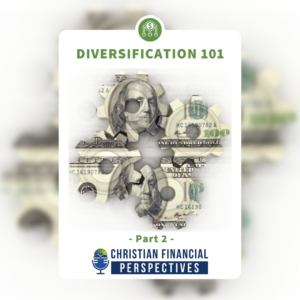Click below to listen to Episode 139 – Diversification 101: Part 2 – Sectors
Subscribe: Apple Podcasts | Google Podcasts | Spotify | Amazon Music | Stitcher | RSS | More
Diversification 101: Part 2 – Sectors

Delve into the world of financial and industry sectors in this latest podcast episode on investment diversification.

In this second part of our three part series on diversification, Bob and Shawn discuss the different sectors and industries in which one can invest. Not only are there several areas of financial industries and sectors, but each of these are divided further, and those are divided smaller as well. A well diversified financial portfolio should include many of these sectors and their subsets.
However, how exactly is this accomplished when there are so many across so many different industries? Find out how and delve into the process of properly diversifying your investment portfolio across the different sectors in this episode on Diversification 101.
HOSTED BY: Bob Barber, CWS®, CKA®
CO-HOST: Shawn Peters
Mentioned In This Episode
Bible Verses In This Episode
ECCLESIASTES 11:2
Invest in seven ventures, yes, in eight; you do not know what disaster may come upon the land.
Want to ask a question about your specific situation? Schedule a complimentary 15 minute phone call.
EPISODE TRANSCRIPT
Intro:
Welcome to Christian Financial Perspectives, where you’re invited to gain insight, wisdom, and knowledge about how Christians integrate their faith, life, and finances with a biblical worldview. Here’s your Christian Financial Advisors’ host, Bob Barber and his co-host, Shawn Peters.
Shawn:
Welcome to another episode of Christian Financial Perspectives. I’m so glad that you’ve joined us today, whether you’re watching this online, on YouTube, or you’re listening in on one of the podcast directories. If you are on YouTube and you like this kind of content where we cover financial advice and other topics but from a Christian and biblical perspective, we’d love it for you to like this video, share it with others, and especially hit that subscribe button, so you can know anytime we release a new video. And today, we’re gonna be covering part two of our three part series on diversification. Bob, you want to get us started?
Bob:
An exciting subject to me because we’re into this every single day. This program is a good program for DIY, the do it yourself worker, or somebody that just wants to know how we at Christian Financial Advisors, how we build our portfolios, which is pretty complex. And I thought in the beginning, Shawn, I was gonna be able to do this in one part, and then I realized as I got deeper in, it was gonna take three different parts to do this or else we’re talking an hour on this, and we don’t wanna lose anybody. Last week, I want to do a recap, so if you didn’t get to see it, I would invite you to go back and take a look at it. It had to do with the equity style and fixed income style charts. There’s nine blocks in each chart. I’m gonna have Garrett right now show you those charts that we went into detail what each one of those blocks meant. So today, what we’re gonna do is we’re going to talk about the 12 sectors that can fit within all 18 of those blocks, Shawn, being that there’s nine in the equities and there’s nine in the fixed income.
Shawn:
That’s right. And then we go into all the different sectors. And before we get that much further, let’s go ahead and read Ecclesiastes 11:2. This is from the NIV, “Invest in seven ventures. Yes, in eight, you do not know what disaster may come upon the land.” And I feel like that fits pretty well with diversification and coming from arguably the wealthiest, by a small margin, man that ever lived. What was it? I think Austin told us it was something like $6-7 trillion dollars, like adjusted for today’s.
Bob:
If Solomon would’ve been living today, and there’s nobody in the world now.
Shawn:
To my knowledge, we don’t have any trillionaires.
Bob:
Right. We just have a lot of billionaires.
Shawn:
We have billionaires, like multiple hundreds of billions. But I feel like anything with a trillion, if that’s your net worth like Solomon would’ve had, I feel like you’re probably first place.
Bob:
If Solomon, who knew how to build wealth, you realize he didn’t put it all in one thing, did he? He diversified it over seven or eight sectors. You hear me preaching a lot here about this, especially to those that love real estate. We live in a big real estate town. A lot of people have gotten wealthy on real estate, and they think that everything should be put in real estate. Well, that flies right in the face of a scriptural principle.
Shawn:
That’s right. And there’s also a scriptural principle about there’s a time for everything. So, yeah. You may have done well for quite some time with real estate, but just like any other market, they all go through cycles, which is why you would be prudent to diversify properly, which means not just real estate. And before we go further, Bob, I actually have something really exciting, especially if anyone is watching, listening that didn’t get our last episode. But we’re very excited to announce we have a new program that we’re calling “Tier Genesis”. And we’ve made this in mind with those who are a little more DIY, as well as those who are households that wouldn’t meet our normal $100,000 total assets minimum. And so, this is a program that is an all digital program, and you can go directly to the website and sign up and get started. You’ll have access to the same investment management that we do for all of our clients already, but by offering it through a little bit different of a program and service, we can help those who don’t meet our normal minimum, but are maybe young family or young professional people trying to get started, or those who just maybe haven’t built up as much, as well as if you are the type of DIY with your advisor where, “Don’t call me, I’ll call you.” So then this might be for you.
Bob:
Maybe you have $500,000 or even 2 million or 3 million.
Shawn:
And you just want what we do, but don’t call me all the time. I’ll call you when I need you. Well, this is for you. And so if you wanna learn more about that, or if you’re really excited, you’re like, Hey, I wanna get started, check out tiergenesis.com. That’s T-I-E-R genesis.com. We’ll have that in the description and on the screen as well.
Bob:
And now we’re gonna get into the sectors. And hopefully, we’re gonna try to do this very quickly. Garrett’s going to be putting up each sector, but then we’re gonna talk about within each sector the industries of those sectors. So you’ve got 12 different sectors. First one is healthcare. So Shawn, the four industries that we invest in when we look at healthcare are…
Shawn:
1) We have healthcare equipment and supplies. And then we have 2) Healthcare providers and services, 3) Biotechnology, and 4) Pharmaceuticals.
Bob:
You can see how those four break down. The providers could be hospitals. The biotechnology would be the inventing the arm or medicine. Pharmaceuticals would come under, like we had Eventide on one time and they talked about schizophrenia, but that kind of comes under biotechnology at the same. It can fall there.
Shawn:
The point is there’s a lot of variety.
Bob:
There’s a lot of variety in healthcare.
Shawn:
You have a sector as healthcare. And then you have those four industries and even to an extent, those four industries, you could kind of subdivide those into a bunch of different areas as well.
Bob:
You sure can. Right. So the second area is communication services, and this involves…
Shawn:
Three primary industries. We have 1) Telecommunications, we have 2) Media wireless,
Bob:
Like wireless phones.
Shawn:
And 3) We have entertainment and internet media.
Bob:
Netflix.
Shawn:
Yeah. I don’t know if anybody’s ever heard of that. It’s a streaming company.
Bob:
Watching Friday Night Lights right now on it from a long time ago. I never saw that, and I’m really enjoying it. Like I was telling you earlier, it’s making me, I’m like looking and watching this series. I’m going, that is too realistic, too much like my town I grew up in.
Shawn:
Which is not something you normally think of when you watch a show.
Bob:
No, it’s not.
Shawn:
Hey, this is realistic, but sometimes it happens.
Bob:
We’ve covered healthcare communication services. Next is…
Shawn:
Number 3 is technology divided into four primary industries. We have 1) Internet software and service companies, 2) We have IT consulting services, 3) We have semiconductor equipment, and 4) We have computers and peripherals.
Bob:
So far, we’ve gone through three. Sounds confusing, doesn’t it? I mean, if you wanna do it yourself, that’s fine, if you love this stuff like we do, but we’re showing you how we take all these different sectors and then the industries under each sector, and we put that into an investment portfolio. Next week in part three, we will be talking about how we apply this and use that equity style chart and fixed income style chart for each one, because every one of these has companies and they fit somewhere in that equity style chart.
Shawn:
That’s right.
Bob:
It could be a small cap, large cap, mid-cap. It could be a growth or value or somewhere in between company. So, they all fit within one of those nine.
Shawn:
And obviously, one of the reasons why we want to cover these sectors and the sub industries or industries is because even if you used those charts and you had large, small cap, mid cap you had these different areas and you were really diversified, if all of those different positions from the equity and the fixed income were all from one primary sector or from only a couple industries, then you’re not as diversified as you might think because you’re missing a piece of it. So that’s kind of why we thought this would be a good part 2 to go over these sectors and industries.
Bob:
And you can overweight these sectors or underweight the sectors depending on where the markets are. Like a few years ago, if you remember oil, was it under $20? $20? I mean, it went negative there for a while during COVID. and then it went up to $120 this last summer. And now as we are doing the program, as we’re making the program, it’s in the mid seventies per barrel. So you look at overweighting energy as an example, a couple years ago when nobody wanted to invest in it, that’s the time when you wanna invest in it. When everybody, and I’m telling you Shawn, cause I watched CNBC this last summer. Everybody’s saying, you gotta get into oil, gotta get into oil. And I’m going, no. It’s $120 a barrel.
Shawn:
It was interesting, because in late 2020 when we moved into energy when nobody really wanted to move into energy, and it was down quite a bit. And meanwhile everybody’s talking about technology stocks, which were skyrocketing, right? Like, well then when those flip around, like, well, now maybe if the technology stocks continue dropping like they have been, at least as the time of recording, maybe now’s the time to invest in technology and not invest in energy.
Bob:
So you gotta watch all these sectors. So the Ford sector is what we refer to as “consumer discretionary”. And that has to do with like retail. How much money do you have to go spend in retail, automobiles, consumer durables, apparels, hotels. You would think, well that’s travel, but that’s consumer discretionary. That’s discretionary spending. You don’t have to go to a hotel. That’s additional dollars that you have to spend in restaurants. Now, consumer discretionary, can you imagine would do better in a good economy, right?
Shawn:
Yeah. When people have more discretionary income to spend. It kinda almost seems like it goes together with the title there.
Bob:
Yes. Correct.
Shawn:
So there are those six, and then our fifth sector we have is consumer staples, and it’s divided into six primary industries. We have food and drug, we have beverages, we have food products. Oh, sorry, that was food and drug retailing. Then 2) Beverages, 3) Food products, 4) Tobacco.
Bob:
Which we would not invest in.
Shawn:
Right. No. Again, yeah. We’re not making any recommendations in general, like on this program that we’re just listing what they are.
Bob:
I just wanna make sure people know we will not invest in tobacco here.
Shawn:
5) Household products, 6) Personal products.
Bob:
And this did really well back in COVID there, your Walmarts and like your Krogers and your big grocery store chains did very well because these are consumer staples. These are things that people gotta have, and they need now.
Shawn:
In 2020, I think the toilet paper companies had probably record sales, right?
Bob:
You remember that.
Shawn:
People buying six years worth of toilet paper for some reason. Like, guys, come on. We’re gonna have more toilet paper.
Bob:
I’ll never forget that. I remember taking pictures of that. And it’s like, you can’t get paper towels. You can’t get toilet paper. And it’s like, it was insane. The run we had on that, and then people were trying to turn around and flip it, and sell it at high prices.
Shawn:
I never thought I’d see the day that people were scalping toilet paper online.
Bob:
So, we’re nearly halfway through, which the sixth one we were just talking about is energy. But energy breaks down. It’s not just gas in your car.
Shawn:
That’s right. It’s got five primary sub industries. We’ve got 1) Crude oil, 2) Natural gas, 3) Drilling, 4) Refining, and 5) Energy related services.
Bob:
And all these will drive energy prices. Like as an example, when energy was very, very low, those that were drilling were like, it’s not worth it. But prices went to $120 a barrel. Now, everybody’s drilling. And now what’s happening is you’ve got so many drilling that you have extra supply coming onto the market that will drive the price back down. It will get down to a certain point where they’ll stop drilling. They’ll say, this is not worth it again. It’s just a cycle. And like it goes with Ecclesiastes says there’s a time for everything. That’s why all these, you’ll have energy that will rotate, but then you’ll have the industries within energy will rotate back and forth as well.
Shawn:
Well, and when you get into energy, I think that’s an interesting example is that if the prices are really high, like for the oil, then obviously there’s gonna be more of a drive for drilling and it’s exploratory drilling. But when it comes to the refinery, what’s interesting is if the oil was already purchased, the energy companies, they don’t have to refine it. They can kind of turn the valve up or down a little bit, depending on like what the market demand is because they’re trying to make as much as they can per gallon of gas or diesel or per gallon for the oil. So why would they wanna sell more if they don’t make as much? If anything, just pull that supply back a little bit, don’t refine as fast. The people always wanna blame the government or whatever political party, but energy companies have a lot of different play in that, too.
Bob:
And as we think about one of these sectors. I was just thinking about something when my head was spinning as you were doing it about energy. There’s an old Texas company here called Southwest Airlines. And they are known that when energy goes way down, they go in and buy a lot of, I mean, when oil prices are way down, they’ll go in and hedge it and they’ll buy it for a couple years. You wonder if they went and did that during COVID when oil basically went to zero for.
Shawn:
I remember seeing that in the news. I don’t remember how many years ago it was, but I remember that coming out where a lot of the airlines were really struggling when prices had gone up quite a bit. And Southwest, of course, was in the news about like, oh, well they’re actually doing great cuz they bought a whole bunch previous, or they hedged it, you know? That’s interesting.
Bob:
Next, we have financials. So this is gonna break down into financial services firms like ours. Also, banks, insurance, this insurance industry. Then you have your overall capital markets, your consumer finance, like your credit cards and then thrift companies. So all these different sectors and you’ll notice again, a lot of rotation within the financial. I saw that over the last couple of years between which one of these one of these industries would be hot while another one wasn’t.
Shawn:
Okay. So our eighth sector is industrials, and we’ve got 10 industries.
Bob:
Oh, that’s a lot of there. Go ahead.
Shawn:
So number 1) Aerospace and defense, 2) Building products, 3) Construction and engineering, 4) Electrical equipment, 5) Machinery, 6) Commercial services and supplies, 7) Air freight and logistics, 8) Airlines, 9) Marine, and 10) Road and rail.
Bob:
I have a feeling when we’re listing all these now people are starting to go, okay, can I listen to this much longer? I’m starting to have brain overload and that’s what will happen. Now like I say, if you wanna build the portfolios yourself, you can. And you use this information to do that. And that’s very good for the DIY. If you’re finding yourself as you’re listening this going, this is so much, I’m becoming overwhelmed. Again, we just mentioned at the beginning of our program, Tier Genesis. We have our Tier Genesis program coming out for anyone that can go online, tiergenesis.com and you’ll get these sectors, and we’re putting these sectors depending on where the markets are – overweighting or underweighting – into our equity style boxes that we talked about in part one.
Shawn:
We’re basically, thing of it is this, if this seems like a lot of information, either that’s good if you’re trying to do more of this on your own, or maybe you need an advisor.
Bob:
Yes.
Shawn:
Maybe it’s us, maybe not. But we just figured it would be good to both help some DIY people and also allow you guys to kind of peek under the hood to an extent to see what’s going on, what goes on in our day-to-day life and how we do what we do.
Bob:
Just so you know, there’s only three more. I know we’ve gone through a lot of these and it’s a lot of information. The last three are materials, well actually four more. We’ve got materials, utilities…
Shawn:
Real estate.
Bob:
Real estate, and then physical assets. Boy, Shawn, I’ll tell you what we need to do. There’s so many different sectors in here. Let’s just try to hit on some of these because I think we’re getting so deep into this, I can see where this could… I think I’ve had people sit across the desk from me before and they’ve actually said, you’re gonna make my head explode if you keep bringing this on.
Shawn:
Well, let’s just hit a highlight a few industries here, each one. So for number nine materials, we’ve got things like chemicals, construction materials, metals and mining, those kinds of things, paper forests. Number 10 for the sector, we’ve got utility or utilities, really just kind of one industry, but you’ve got companies that produce, generate, transmit, or distribute electricity, or you have companies that produce, generate, and transmit natural gas.
Bob:
Exactly. Our last major sector is real estate. Now, people don’t realize that there are 14 different industries within real estate.
Shawn:
So, we’re not gonna hit all of those.
Bob:
No, we’re not, but you do have your big industrial buildings, you’ve got your retail buildings. You’ve got your lodging, you have your offices, and then you have your residential.
Shawn:
Yeah. Then you have residential.
Bob:
Which apartments come into that, too. All right.
Shawn:
And then just to name a couple more. You have things like healthcare is its own industry under real estate.
Bob:
Interesting. See, that came under real estate. So, you’ve got the hospital itself. It’s the building that it sits in.
Shawn:
Exactly. So, two separate things. You could be investing in the service of the hospitals. Or you could be investing in the real estate of the hospital. Things like that. A couple other ones I think is interesting – data centers and then timber land.
Bob:
I like the one of cell phone towers, because that is real estate and you see there’s cell phone towers everywhere. So, that’s just a few of them. And then we get to our last one, which is physical assets. That is gold and silver and actual equipment. All right. Things that you can touch now.
Shawn:
So what would be a good example of that, Bob, for equipment? And I mean, I’m sure everybody watching or listening knows probably what gold and silver are, but what would equipment be as a physical asset sector?
Bob:
Caterpillar. John Deere. So, those are examples right there of investing equipment.
Shawn:
Gotcha.
Bob:
All right. So there you go. That is the 12 sectors. On the last program, again, we discussed the equity style charts. And the next and last of our series on diversification, we’re gonna be discussing how you take these sectors and build actual portfolios, which we’re gonna be going over our ultra-conservative portfolio, conservative, moderate, growth, and aggressive growth. And we’ll be talking about how you overweight and underweight these different sectors and the style charts.
Shawn:
And if you’re watching this video on YouTube, we’d love to hear from you. You can comment maybe what sector do you think looks like might have a comeback in 2023, or what’s one maybe you’re interested in? I’m sure you’ve memorized all these by now.
Bob:
Oh, sure.
Shawn:
You’ve got it after hearing them. But we just love, or just in general, just leave us a comment and tell us maybe a topic you might like to see us cover.
Bob:
And we hope this has been very educational to you. By the way, if you need some financial advice and you would like to hire somebody to do all this for you, we are fee-based, fiduciary based advisor, and you can find us on the web at www.ChristianFA.com or www.christianfinancialadvisors.com and our phone number during business hours (830) 609-6986. You can text or call that number.
Shawn:
That’s right. Thanks again for joining us. God bless. And until next time,
Outro:
We invite you to listen to all of our past episodes, covering many financial topics from a Christian perspective. To make sure you don’t miss any of Bob’s upcoming episodes. You can subscribe to Christian Financial Perspectives on iTunes, Google Podcasts, Spotify, Stitcher, or Amazon Music to learn more about integrating your faith with your finances. Visit Christianfinancialadvisors.com or call (830) 609-6986.
Disclosures:
Investment advisory services offered through Christian Investment Advisors, Inc DBA Christian Financial Advisors also known as Christian Financial Advisors Management Group, a registered investment advisor. Comments from today’s show for informational purposes only, and not to be considered investment advice or recommendations to buy or sell any company that may have been mentioned or discussed. The opinions expressed are solely those of the host Bob Barber and his guests. Bob does not provide tax advice and encourages you to seek guidance from a tax professional. While Christian Investment Advisors believes the information to be accurate and reliable, we do not claim or have responsibility for its completeness, accuracy, or reliability.










